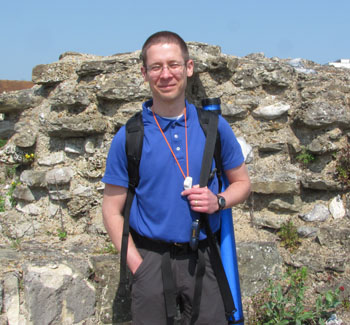2010 Best Student Poster winner goes to
2011 BSDB meeting
By Eric T. Domyan
Eric
is a 5th-year graduate student in
Xin Sun’s lab at the University of
Wisconsin-Madison. He won the Best Student Poster
Competition at SDB's 69th Annual Meeting held in
Albuquerque, NM, August, 2010. He studies patterning
and morphogenesis of the mouse respiratory and
digestive tracts and his winning poster was entitled
"Signaling through BMP
receptors promotes respiratory identity in the
foregut through repression of SOX2." His prize
was a trip to the British SDB’s spring meeting to
present this paper. SDB covered his travel expenses
and BSDB hosted his stay throughout the meeting. SDB
will host the BSDB meeting’s poster winner, Emma
Broom of King’s College London at the meeting in
Chicago.
|
 |
|
Eric at St. Augustine’s Abbey in
Canterbury. |
While not receiving as much attention as the British Royal Wedding, another exciting event was held in the U.K. this April. The 2011
Joint Meeting of the British Societies for Developmental and Cell Biology occurred at the University of Kent in Canterbury, which as the 2010 U.S. SDB Student Poster Award winner, I was privileged to attend. The four-day conference featured a wide variety of speakers, predominantly from the U.K. and other European countries, and was an incredible opportunity to share research findings, learn new methodologies, and establish new friendships.
While the conference hosted a wide variety of presenters, several themes quickly became apparent. One theme I encountered was that studies and techniques developed in a particular organism, or for a particular developmental process, can be fruitfully applied in new contexts. The plenary speaker (who also happens to reside on this side of the Atlantic),
Mark Krasnow of Stanford, demonstrated how genetic lineage labeling techniques first employed in Drosophila can be applied in mouse to yield new insights into the cellular biology of lung development and disease.
Chris Wylie, a British native now at the University of Cincinnati, was awarded the Waddington Medal at this year’s conference. In a similar vein to Dr. Krasnow’s talk, he presented data suggesting that studies of notochord function during embryonic development may be fruitfully utilized to investigate the basis of scoliosis in adolescents.
Another prominent theme was that the integration of traditional gene expression studies and mutant analyses with mathematical modeling schemes can produce new insights into the underlying biology of development.
Johannes Jaeger of the University of Barcelona analyzed the expression of the gap gene network at closely spaced time intervals in Drosophila embryos. By integrating this with a computational model, he was able to demonstrate that slight shifts in gap gene expression domains over time result from weak repressive interactions among members of the network. Anna Kicheva, a postdoc in
James Briscoe’s lab at MRC, also utilized models to investigate how patterning and growth of the mouse spinal cord are coordinated. She found that while the sizes of distinct neuronal progenitor populations increase at different rates, this is not due to differences in proliferation. Rather, the probability of progenitor differentiation varies among populations, thus accounting for the observed changes in progenitor population size. These and other talks convinced me that studies integrating data gleaned from “wet lab” experiments with computational models will continue to gain in importance in developmental biology research, and I either need to bone up on my math a bit, or make some good friends in the mathematical sciences!
Many researchers also described their investigations into how developmental processes vary over micro- and macroevolutionary scales.
Sigfried Roth of the University of Cologne presented work investigating how the mechanism of dorsal-ventral (D-V) axis patterning varies among insect clades. His work uncovers the gradual transition from a Bmp-only system of D-V patterning to a system utilizing mutually antagonistic interactions between Bmp and Toll signaling pathways. While the adaptive significance of this transition is unknown, it will provide an intriguing area for future research. At an intraspecific level,
Dennis Headon of the University of Edinburgh presented work on the genetic basis of feather patterning between chicken breeds. Chickens with the Naked neck mutation lack feathers only on their neck relative to wild-type chickens, although they show an upregulation of the feather-inhibitory gene Bmp12 throughout the entire skin. Subsequent work demonstrates that the absence of neck feathers is caused by high levels of retinoic acid signaling in the neck, which makes this region of the body more sensitive to the feather-inhibitory effects of Bmp12. This work highlights how a cryptic pattern of one pathway (retinoic acid) can be revealed by a global change in another pathway (Bmp). These and other presenters vividly illustrated the power of expanding developmental studies to organisms beyond the standard models.
Of course, in addition to the lectures and poster presentations, there were ample opportunities for socialization in more relaxed settings. During these times, I had the opportunity to compare notes with other graduate students (both in terms of research and life as a researcher), and to establish contacts that will hopefully lead to new ideas and collaborations. I also had some time to tour Canterbury, and gain an appreciation for the depth of history that exists there. I was able to set foot on the site where St. Augustine established an abbey in the 6th century C.E., thereby bringing England in contact with the rest of Europe. I also viewed Canterbury Cathedral, made famous through King Henry VIII’s somewhat troubled quest for a male heir in the 16th century. I also, of course, found at least one opportunity to dine on the quintessential English meal, fish and chips! As a whole, I found my attendance at the 2011 BSDB conference to be extremely rewarding at both a professional and personal level. I am extremely grateful to the SDB here in the US for making this opportunity possible, and I look forward to congratulating this year’s Best Student Poster Awardee!
|